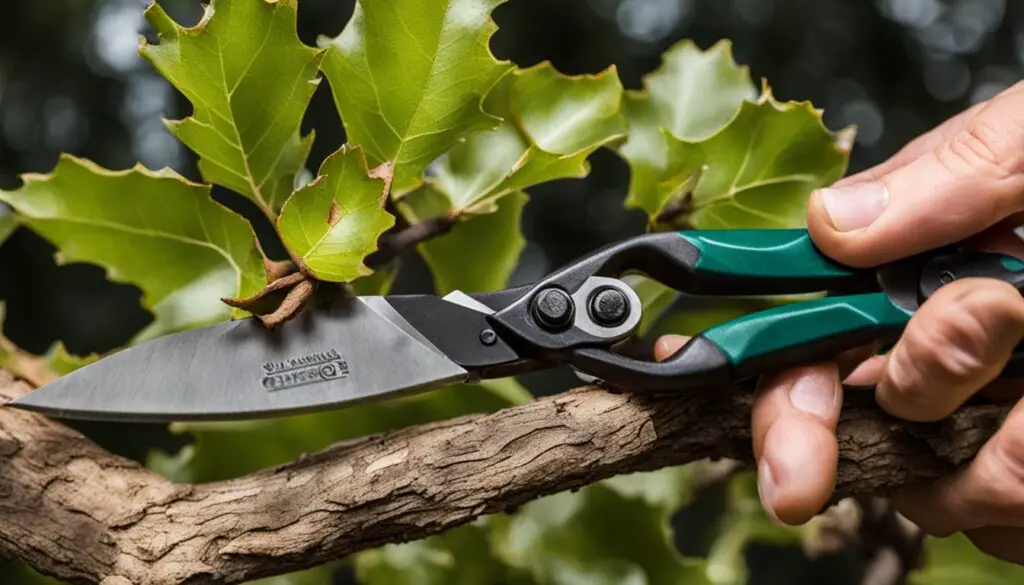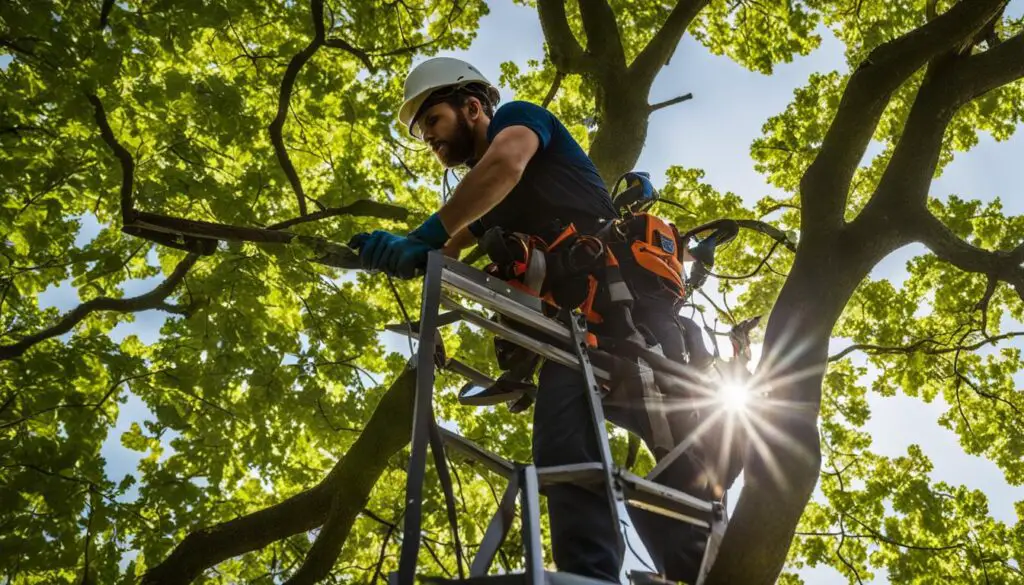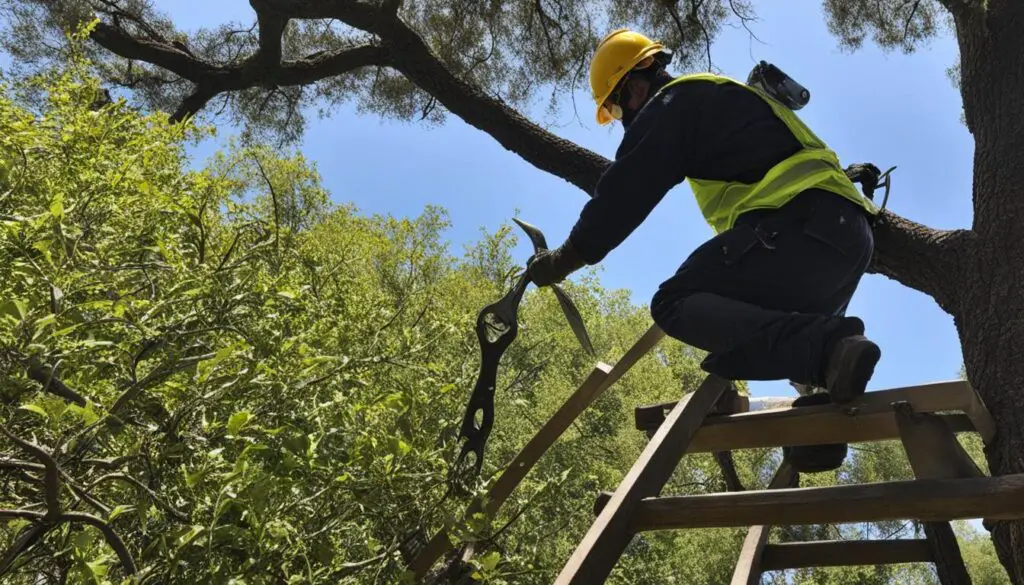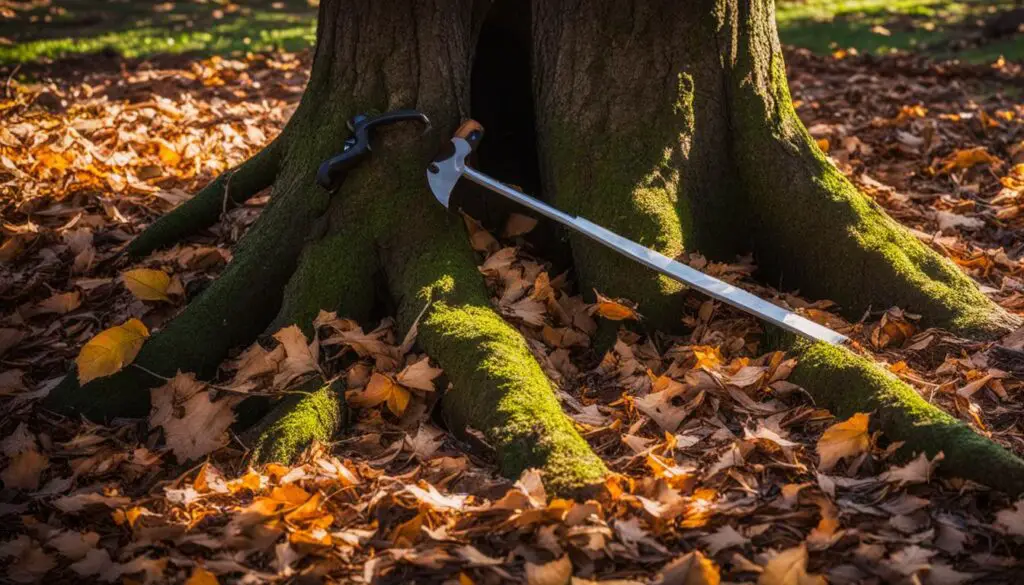Properly maintaining your oak trees is essential for their health and longevity. One crucial aspect of oak tree maintenance is trimming or pruning. Knowing when to trim oak trees is key to achieving the best results and promoting their growth. In this expert guide, we will explore the optimal time for oak tree pruning and provide you with essential tips for pruning oak trees.
Key Takeaways:
- The best time to trim oak trees is during the winter months between November and April to avoid the spread of oak wilt disease.
- Pruning during the growth season requires immediate dressing of wounds with protective sealant to reduce the risk of disease.
- Proper tools and equipment, such as pruning shears, limb saws, and chainsaws, are necessary for effective oak tree trimming.
- Basic oak pruning techniques include thinning, crown raising, and reducing to improve tree health and structure.
- When cutting oak branches, make clean cuts outside the branch collar and seal the wounds with pruning sealant.
Tools for Oak Tree Trimming
When it comes to oak tree trimming, having the right tools and equipment can make all the difference. Proper tools not only ensure a safer work environment but also contribute to the effective and efficient trimming of oak trees. Here are some essential tools for oak tree trimming:
- Hardhat and Safety Goggles: Protect yourself from potential hazards by wearing a sturdy hardhat and safety goggles.
- Pruning Shears and Lopping Shears: These tools are ideal for cutting smaller branches, allowing for more precise and controlled trimming.
- Limb Saw or Buck Saw: For larger branches that require more cutting power, a limb saw or buck saw is recommended.
- Pole Pruner: Reach higher branches with ease using a pole pruner, which extends your reach without compromising safety.
- Rope Saw: When faced with hard-to-reach branches, a rope saw is a handy tool for navigating those tricky spots.
- Chainsaw: If you have experience using a chainsaw, it can be a valuable tool for tackling larger oak tree trimming tasks.
- Non-Asphalt Pruning Sealant or Exterior Latex Paint: After trimming oak trees, it’s essential to seal the wounds with a non-asphalt pruning sealant or exterior latex paint to promote healing and protect against disease.
With these tools at your disposal, you’ll be well-equipped to trim oak trees effectively and maintain their health and beauty.
Basic Oak Pruning Techniques
Proper pruning techniques are essential for maintaining the health and aesthetics of oak trees. Basic oak pruning techniques include thinning, crown raising, and reducing. Let’s explore each technique in detail:
Thinning
Thinning involves the removal of dead branches, clusters of dead leaves and twigs, as well as crossed or rubbing branches. By eliminating these unhealthy and competing elements, the tree’s overall health and vigor can improve significantly. Thinning also enhances light penetration and air circulation within the tree’s canopy, which is essential for optimal growth and development.
Crown Raising
Crown raising focuses on removing lower limbs up to 8 feet from the ground, effectively creating a park-like space beneath the tree. This technique is particularly useful for enhancing visibility, allowing for easy movement, and accommodating vehicles or pedestrians underneath. For trees measuring less than 24 feet in height, crown raising to one-third of the total height is recommended for a balanced visual appearance.
Reducing
Reducing involves the selective cutting of limbs and branches to reduce the overall size of the tree. This technique is often necessary in situations where the tree’s growth interferes with power lines, buildings, or other structures. By carefully removing specific branches, the tree’s size can be managed while preserving its overall health and form.
When performing any pruning technique, it is important to prioritize the tree’s well-being and consider the long-term effects of the cuts made. Remember to always follow proper pruning practices to ensure the health and longevity of your oak tree.
| Technique | Description |
|---|---|
| Thinning | Removal of dead branches, leaves, and twigs; improves light and air circulation; eliminates competition |
| Crown Raising | Removal of lower limbs up to 8 feet from the ground; creates a park-like space beneath the tree |
| Reducing | Selective cutting of limbs and branches to make the tree smaller; necessary around power lines or structures |
Cutting and Sealing Oaks
When it comes to cutting branches on oak trees, it is crucial to make clean cuts outside of the branch collar. The branch collar is the swelling at the base of the branch where it connects to the trunk. By cutting outside of this area, you allow for proper healing and reduce the risk of disease.
Branches should be cut about 3 inches from the intersection with another larger branch. Start cutting from underneath, making a one-third cut through the branch. Then, cut as close as possible to the other branch without damaging it. This technique helps to minimize any potential damage and ensures the tree’s growth is not compromised.
When dealing with larger branches, it is essential to exercise caution to avoid breakage and leaving jagged edges. Make clean, smooth cuts to promote faster healing and reduce the risk of pests and diseases. Remember that jagged cuts can create entry points for insects and pathogens, compromising the tree’s health.
After cutting, it is crucial to seal the wounds with a non-asphalt pruning sealant or exterior latex paint. This sealant acts as a protective barrier, preventing diseases and insect infestations from entering the tree. Apply the sealant to all pruning cuts, regardless of the season, to ensure the tree’s well-being and reduce the risk of infections.
| Cutting and Sealing Oaks | |
|---|---|
| Technique | Benefits |
| Cut outside of the branch collar | Promotes proper healing and reduces disease risk |
| Cut branches about 3 inches from the intersection | Minimizes damage and promotes healthy growth |
| Make clean, smooth cuts on larger branches | Prevents jagged edges and reduces pest/disease risks |
| Seal wounds with non-asphalt pruning sealant or exterior latex paint | Protects against infections and promotes tree health |

Oak Tree Trimming Tools for Homeowners
When it comes to trimming oak trees, homeowners need the right tools to get the job done efficiently and safely. Whether you’re pruning for aesthetics, maintaining tree health, or managing overgrowth, having the right equipment ensures a successful outcome. Here are some essential tools every homeowner should have for DIY oak tree pruning:
- Pruning Shears: These handy handheld tools are perfect for cutting small branches, twigs, and foliage. Look for sharp, bypass-style shears for clean and precise cuts.
- Lopping Shears: Designed for larger branches, lopping shears provide the extra reach and cutting capacity necessary for pruning thicker limbs. They feature long handles and compound leverage for increased cutting power.
- Limb Saw or Buck Saw: When facing branches that are too thick for shears, a limb saw or buck saw comes to the rescue. These tools are designed to cut thicker branches efficiently, ensuring a clean and controlled pruning process.
It’s important to remember that using these tools requires proper technique and safety precautions. Always wear a hardhat, safety goggles, and gloves to protect yourself from falling debris and sharp objects. Follow the manufacturer’s instructions and guidelines for each tool to ensure safe and effective use.
When to Call a Professional for Oak Tree Trimming
While smaller oak tree trimming tasks can be done by homeowners, larger or more complex trimming jobs should be left to professionals. This is especially true for trimming higher branches or branches near power sources. If homeowners are unsure about their ability to safely and effectively prune their oak trees, it is best to contact a tree service or a certified arborist for an estimate. Professionals can handle the more difficult portions of the job and homeowners can take care of the cleanup and smaller tasks themselves to save on costs.
When it comes to oak tree trimming, there are certain situations where hiring a professional is highly recommended. Here are a few instances when it’s best to call in the experts:
- Trimming higher branches: If the branches of your oak tree extend beyond your reach or require climbing a ladder, it’s safer to leave the job to professionals who have the necessary equipment and expertise to work at heights.
- Branches near power sources: If there are branches that are dangerously close to power lines or electrical equipment, it’s essential to hire professionals who are trained to work around these hazards effectively.
- Complex or large-scale trimming: When the tree requires extensive pruning or has multiple branches that need to be removed, it’s best to rely on professionals who have the experience and knowledge to perform the task safely and efficiently.
By entrusting oak tree trimming to professionals, homeowners can ensure that the job is done correctly and without any risk to their safety or the health of the tree. Additionally, tree services or certified arborists can provide valuable advice and recommendations for long-term oak tree maintenance, ensuring the continued health and beauty of your oak trees.

Pruning Tips for Young Oak Trees
Young oak trees require proper pruning techniques to shape their growth and promote healthy development. By pruning in the second or third year after planting, you can guide the tree’s structure and encourage optimal growth. Mid to late winter is the recommended time for pruning young oak trees.
The pruning process for young oak trees focuses on removing dead or broken branches and shaping the tree by selecting a dominant leader branch. The dominant leader should be the largest and most vertical branch that is centered on the trunk. Trimming back other branches that may become multiple leaders allows more sunlight to reach the dominant leader, promoting its growth and strength.
Regular pruning of young oak trees helps to establish a strong structure and ensures proper growth. By shaping the tree’s development early on, you can encourage a healthy and beautiful oak tree for years to come.
Take a look at the image below to see an example of how to prune young oak trees:
Tips for Pruning Young Oak Trees:
- Start pruning in the second or third year after planting.
- Prune during mid to late winter.
- Remove dead or broken branches.
- Select a dominant leader branch.
- Trim back other branches that may become multiple leaders.
- Ensure the dominant leader receives ample sunlight.
- Regularly prune to promote proper growth and structure.
Best Practices for Oak Tree Pruning
When it comes to pruning oak trees, following best practices is crucial for maintaining their health and vigor. Proper techniques not only ensure the tree’s well-being but also improve its aesthetic appeal. Here are some essential tips for proper oak tree trimming:
- Avoid heading cuts: When trimming oak trees, it’s important to avoid making heading cuts. Heading cuts involve cutting branches back to an arbitrary point, which disrupts the tree’s natural growth patterns. Instead, focus on removing dead, damaged, or diseased branches by cutting them back to a branch collar.
- Avoid lion tailing: Lion tailing refers to the practice of removing interior branches, leaving only growth at the ends of the branches. This can reduce the foliage required for photosynthesis and increase the risk of wind damage. To maintain a healthy tree, it’s best to retain a balanced distribution of foliage throughout the crown.
- Avoid flush cuts: Flush cuts, where branches are pruned flush with the point of attachment, should be avoided. This type of cut leaves the tree vulnerable to pests and bacteria. Instead, use the 3-cut method for larger branches. Start by making an undercut, followed by a top cut, and finally, a final cut just outside the branch collar. This technique minimizes bark damage and promotes proper healing.
Following these best practices will help ensure the long-term health and vitality of your oak trees. Remember to always use proper pruning techniques and seek professional help for larger or more complex pruning jobs.
| Best Practices for Oak Tree Pruning | Benefits |
|---|---|
| Avoid heading cuts | Preserves natural growth patterns and ensures proper healing |
| Avoid lion tailing | Maintains a balanced distribution of foliage and reduces the risk of wind damage |
| Avoid flush cuts | Prevents pests and bacteria from entering the tree and promotes proper healing |

Post-Pruning Care for Oak Trees
After pruning oak trees, it is crucial to provide proper post-pruning care to support healing and ensure the long-term health of the tree. One essential step in post-pruning care is the application of a pruning sealant to all wounds, regardless of the season. The sealant acts as a protective barrier, preventing disease and insect infestation. By sealing the wounds, you create a barrier that reduces the chances of infections reaching the vulnerable areas.
Proper pruning sealants create an environment that supports healing and reduces the risk of pathogens entering the tree. Whether you choose a non-asphalt pruning sealant or exterior latex paint, make sure to apply it thoroughly to all pruned areas. This sealant will dry and form a protective layer, helping your oak tree recover more effectively.
When pruning oak trees, it is essential to dispose of any removed branches properly. Diseased or infested branches can spread harmful pathogens to healthy parts of the tree or even other nearby trees. Be sure to bag and dispose of pruned branches according to local waste disposal guidelines, preventing the risk of disease transmission.
Additionally, providing sufficient water and regular maintenance to the oak tree can help support its overall health and recovery after pruning. Water the tree deeply, allowing the soil to absorb the moisture and nourish the roots. Proper irrigation helps promote healthy regrowth and ensures the tree has the necessary resources for healing.
By following these post-pruning care tips, you can aid in the recovery of your oak tree and maintain its long-term health and vitality.

| Post-Pruning Care Checklist: |
|---|
| Apply a pruning sealant to all wounds |
| Dispose of pruned branches properly to prevent disease spread |
| Provide sufficient water through deep watering |
| Maintain regular maintenance and monitor the tree’s recovery |
When to Trim Mature Oak Trees
Trimming mature oak trees is an important aspect of tree maintenance to ensure their health and longevity. Proper pruning techniques can help enhance the tree’s aesthetics, promote better air circulation, and remove any dead, diseased, or damaged branches. However, it is crucial to approach pruning with careful consideration and follow best practices to minimize any negative impact on the tree.
When it comes to trimming mature oak trees, the goal should be to maintain the natural shape and structure of the tree while addressing specific needs and concerns. Here are some key factors to keep in mind:
- Purposeful pruning: Focus on removing dead, diseased, or damaged branches. This helps to improve the overall health of the tree and reduce the risk of falling branches.
- Sunlight and air flow: Pruning can also be done to create more sunlight and air flow within the canopy of the tree. This promotes better growth and reduces the risk of fungal diseases.
- Shape and weight balance: Careful consideration should be given to the branches that will be pruned to avoid drastic changes in shape or excessive weight loss. It is important to maintain a well-balanced crown.
- Clean cuts: When pruning larger branches, it is crucial to make clean cuts outside the branch collar to prevent tearing and bark damage. This promotes faster healing and reduces the risk of infection.
After pruning mature oak trees, it is advisable to allow the tree to heal naturally without the use of artificial sealants. This allows the tree to develop callus tissue and protects it from potential harm caused by sealants. Monitoring the tree’s growth and performing regular maintenance checks can ensure its overall well-being.
Conclusion
Pruning oak trees is essential for maintaining their health and promoting optimal growth. By following the right techniques and using the proper tools, homeowners can ensure the longevity of their oak trees.
The best time to trim oak trees is during the winter months, between November and April, to minimize the risk of oak wilt disease. By pruning during this time, you can prevent the spread of the disease and protect the overall health of your oak tree.
It’s important to use the right tools, such as pruning shears, lopping shears, and a limb saw, to make clean cuts and minimize damage to the tree. For more complex or larger pruning jobs, it’s advisable to seek the help of professionals to ensure safety and effectiveness.
After pruning, providing proper post-pruning care, including sealing wounds with a protective pruning sealant and disposing of removed branches properly, is crucial for the tree’s recovery. With regular maintenance and following best practices, homeowners can enjoy the beauty and health of their oak trees for years to come.
FAQ
When is the best time to trim oak trees?
Oak trees should be pruned in the winter months between November and April to prevent the spread of oak wilt disease.
What tools are needed for oak tree trimming?
Essential tools for oak tree trimming include hardhat, safety goggles, pruning shears, lopping shears, limb saw, buck saw, pole pruner, rope saw, and chainsaw for experienced homeowners.
What are the basic oak pruning techniques?
Basic oak pruning techniques include thinning, crown raising, and reducing.
How should oak branches be cut and sealed?
Branches should be cut outside the branch collar, and wounds should be sealed with a non-asphalt pruning sealant or exterior latex paint.
What tools are recommended for homeowners to trim oak trees?
Homeowners should have pruning shears, lopping shears, and a limb saw or buck saw for smaller oak tree trimming tasks.
When should a professional be called for oak tree trimming?
Larger or more complex trimming jobs should be left to professionals, especially for trimming higher branches or branches near power sources.
How should young oak trees be pruned?
Pruning should begin in the second or third year after planting, focusing on removing dead or broken branches and shaping the tree by selecting a dominant leader branch.
What are the best practices for oak tree pruning?
Best practices for oak tree pruning include avoiding heading cuts, lion tailing, and flush cuts.
What post-pruning care is needed for oak trees?
After pruning, oak trees should be provided with pruning sealant on all wounds and receive proper water and regular maintenance.
When should mature oak trees be trimmed?
Mature oak trees should be trimmed to remove dead, diseased, or damaged branches and to create more sunlight or air flow within the canopy.

